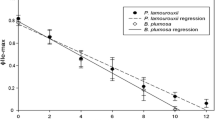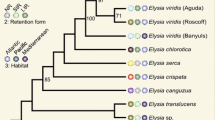Abstract
The planktonic ciliateStrombidium capitatum (Leegaard, 1915) Kahl, 1932 retains functional chloroplasts derived from ingested algal cells. Chloroplast replacement and aging were experimentally investigated in cultured ciliates provided with a cryptophyte (Pyrenomonas salina), a prymnesiophyte (Isochrysis galbana) and a prasinophyte (Pyramimonas sp.) as sources of plastids. All three algae were ingested and chloroplasts from all were retained by the ciliate. Within 15 min of exposure to the cryptophyte, this alga was taken up by the ciliates. Initially, most of the cryptophyte chloroplasts were in intact algal cells in ciliate vacuoles. By 2 h, cryptophyte plastids were commonly found free in the ciliate cytoplasm. WhenS. capitatum was switched from a diet containing cryptophytes to a non-cryptophyte diet, most cryptophyte chloroplasts were diluted out of the ciliates by cell division and/or replaced by non-cryptophyte chloroplasts within 9 h. When the ciliates are not provided with algae, they decrease in size and number. However, the starving ciliate cells contain some chloroplasts for as long as they live (40 h or more). Under these conditions, cryptophyte chloroplasts persist longer than the other chloroplast types. Our observations suggest that chloroplast retention times inS. capitatum depend on the type of chloroplast as well as the availability of phytoplankton containing suitable new chloroplasts, and probably also on the physiological states of the ingested algae and the ciliates. It is interesting that we were not able to grow this ciliate when we provided it only with prey that lacked chloroplasts.
Similar content being viewed by others
Literature cited
Blackbourn, D. J., Taylor, F. J. R., Blackbourn, J. (1973). Foreign organelle retention by ciliates. J. Protozool. 20: 286–288
Caron, D. A. (1987). Grazing of attached bacteria by heterotrophic microflagellates. Microb. Ecol. 13: 203–218
Dodge, J. D. (1973). The fine structure of algal cells. Academic Press, New York
Dodge, J. D. (1979). The phytoglagellates: fine structure and phylogeny. In: Levandowsky, M., Hutner, S. H. (eds.) Biochemistry and physiology of Protozoa, 2nd edn. Academic Press, New York, p. 7–57
Guillard, R. R. L. (1973). Division rates. In: Stein, J. R. (ed.) Handbook of phycological methods — culture methods and growth measurements. Cambridge Univ. Press, Cambridge, p. 290–311
Guillard, R. R. L. (1975). Culture of phytoplankton for feeding marine invertebrates. In: Smith, W. L., Chanley, M. H. (eds.) Culture of marine invertebrate animals. Plenum Publ. Co., New York, p. 29–60
Hawes, C. R., Cobb, A. H. (1980). The effects of starvation on the symbiotic chloroplasts inElysia viridis: a fine structural study. New Phytol. 84: 375–379
Jonsson, P. R. (1987). Photosynthetic assimilation of inorganic carbon in marine oligotrich ciliates (Ciliophora, Oligotrichina). Mar. microb. Fd Webs 2: 55–68
Larsen, J. (1988). An ultrastructural study ofAmphidinium poecilochroum (Dinophyceae), a phagotrophic dinoflagellate feeding on small species of cryptophytes. Phycologia 27: 366–377
Laval-Peuto, M., Febvre M. (1986). On plastid symbiosis inTontonia appendiculariformis (Ciliophora, Oligotrichina). Biosystems (Amsterdam) 19: 137–158
Laval-Peuto, M., Rassoulzadegan, F. (1988). Autofluorescence of marine planktonic Oligotrichina and other ciliates. Hydrobiologia 159: 99–110
Laval-Peuto, M., Salvano, P., Gayol P., Greuet, C. (1986). Mixotrophy in marine planktonic ciliates: ultrastructural study ofTontonia appendiculariformis (Ciliophora, Oligotrichina). Mar. microb. Fd Webs 1: 81–104
Lee, J. J., Lanners, J. J., Kuile, B. T. (1988). The retention of chloroplasts by the ForaminiferElphidium crispum. Symbioses 5: 45–60
Leutenegger, S. (1984). Symbiosis in benthic foraminifera: specificity and host adaptations. J. foraml Res. 14: 16–35
Levy, M. R., Elliott, A. M. (1968). Biochemical and ultrastructural changes inTetrahymena pyriformis during starvation. J. Protozool. 15: 208–222
Lindholm, T., Mörk, A. C. (1989). Symbiotic algae and plastids in planktonic ciliates. Memo. Soc. Fauna Flora fenn. 65: 17–23
Lopez, E. (1979). Algal chloroplasts in the protoplasm of three species of benthic foraminifera: taxonomic affinity, viability and persistence. Mar. Biol. 53: 201–211
Messer, G., Ben-Shaul, Y. (1972). Changes in chloroplast structure during growth ofPeridinium cinctum Fa.westii (Dinophyceae). Phycologia 11: 291–299
Montagnes, D. J. S., Lynn, D. H., Stoecker, D. K., Small, E. B. (1988). Taxonomic descriptions of one new species and redescription of four species in the family Strombidiidae (Ciliophora, Oligotrichida). J. Protozool. 35: 189–197
Patterson, D. J., Dürrschmidt, M. (1987). Selective retention of chloroplasts by algivorous Heliozoa: fortuitous chloroplast symbiosis? Eur. J. Protistol. 23: 51–55
Post, A. F., Dubinsky, Z., Wyman, K., Falkowski, P. G. (1985). Physiological responses of a marine planktonic diatom to transitions in growth irradiance. Mar. Ecol. Prog. Ser. 25: 141–149
Reynolds, E. A. (1963). The use of lead citrate at high pH as an electron-opaque stain in electron microscopy. J. Cell Biol. 17: 208–212
Rhiel, E., Mörschel, E., Wehrmeyer, E. (1985). Correlation of pigment deprivation and ultrastructural organization of thylakoid membranes inCryptomonas maculata following nutrient deficiency. Protoplasma 129: 62–73
Rogerson, A., Finlay, B. J., Berninger, U.-G. (1989). Sequential chloroplasts in the freshwater ciliateStrombidium viride (Ciliophora: Oligotrichida). Trans. Am. microsc. Soc. 108: 117–126
Schnepf, E., Meier, R., Drebes G. (1988). Stability and deformation of diatom chloroplasts during food uptake of the parasitic dinoflagellate,Paulsenella (Dinophyta). Phycologia 27: 283–290
Stoecker, D. K. (in press). Mixotrophy in marine planktonic ciliates: physiological and ecological aspects of plastid-retention by oligotrichs. In: Reid, P. C., Turley, C. M., Burkill, P. H. (eds.) Protozoa and their role in marine processes. NATO ASI Ecological Series, Springer-Verlag, New York
Stoecker, D. K., Michaels, A. E., Davis, L. H. (1987). Large proportion of marine planktonic ciliates found to contain functional chloroplasts. Nature 326: 790–792
Stoecker, D. K., Silver, M. W. (1987). Chloroplast retention by marine planktonic ciliates. Endocytobiology III. Ann. N.Y. Acad. Sci. 503: 562–565
Stoecker, D. K., Silver, M. W., Michaels, A. E., Davis, L. H. (1988). Obligate mixotrophy inLaboea strobila, a ciliate which retains chloroplasts. Mar. Biol. 99: 415–423
Stoecker, D. K., Silver, M. W., Michaels, A. E., Davis, L. H. (1988/1989). Enslavement of algal chloroplasts by fourStrombidium spp. (Ciliophora, Oligotrichida). Mar. microb. Fd Webs 3: 79–100
Thomsen, H. A. (1986). Photosynthetic picoplankton. Can. Bull. Fish. aquat. Sciences 214: 121–158
Trench, R. K. (1979). The cell biology of plant-animal symbiosis. A. Rev. Pl Physiol. 30: 485–531
Trench, R. K. (1980). Uptake, retention and function of chloroplasts in animal cells. In: W. Schwemmler, W., Schenk, H. E. A. (eds.) Endocytobiology. Walter de Gruyter, Berlin
Author information
Authors and Affiliations
Additional information
Communicated by J. Grassle, Woods Hole
Contribution No. 7241 from Woods Hole Oceanographic Institution. This research was supported by NSF grants OCE-8600765 and OCE-8709961 to D.K.S
Rights and permissions
About this article
Cite this article
Stoecker, D.K., Silver, M.W. Replacement and aging of chloroplasts inStrombidium capitatum (Ciliophora: Oligotrichida). Mar. Biol. 107, 491–502 (1990). https://doi.org/10.1007/BF01313434
Accepted:
Issue Date:
DOI: https://doi.org/10.1007/BF01313434




